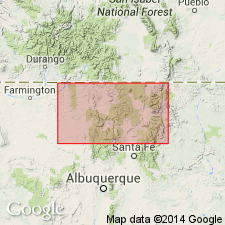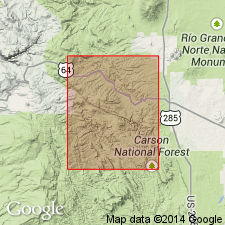
- Usage in publication:
-
- Vallecitos rhyolites
- Modifications:
-
- Original reference
- Dominant lithology:
-
- Rhyolite
- Trachyte
- AAPG geologic province:
-
- Southern Rocky Mountain region
Summary:
Pg. 13 (table 1), 44, pl. 3. Vallecitos rhyolites. A number of rhyolite and trachyte flows, contained in Hopewell series and Ortega quartzite. Trachyte subordinate to rhyolite in amount. In some places, flows are somewhat schistose, but characteristically their original textures (aphanitic ground masses with distinct phenocrysts up to a quarter inch in diameter) have been well preserved and flow banding is well developed. Range in color from deep pink to brick red. Flows are as much as three-fourths mile thick. Thicknesses presumably represent aggregates of flows rather than single flows. Age is Precambrian (Proterzoic).
Notable exposures in mountainous area btw. towns of Petaca and Vallecitos, [La Madera and Las Tablas 7.5-min quadrangles], Rio Arriba Co., central northern NM.
Source: US geologic names lexicon (USGS Bull. 1200, p. 4044).

- Usage in publication:
-
- Vallecitos rhyolites[†]
- Modifications:
-
- [Abandoned]
- AAPG geologic province:
-
- Southern Rocky Mountain region
Summary:
[†Vallecitos rhyolites of Just (1937) considered invalid. Name preempted. Renamed Burned Mountain metarhyolite. See entry under Burned Mountain.]
Source: US geologic names lexicon (USGS Bull. 1200, Burned Mountain entry p. 544).
For more information, please contact Nancy Stamm, Geologic Names Committee Secretary.
Asterisk (*) indicates published by U.S. Geological Survey authors.
"No current usage" (†) implies that a name has been abandoned or has fallen into disuse. Former usage and, if known, replacement name given in parentheses ( ).
Slash (/) indicates name conflicts with nomenclatural guidelines (CSN, 1933; ACSN, 1961, 1970; NACSN, 1983, 2005, 2021). May be explained within brackets ([ ]).

